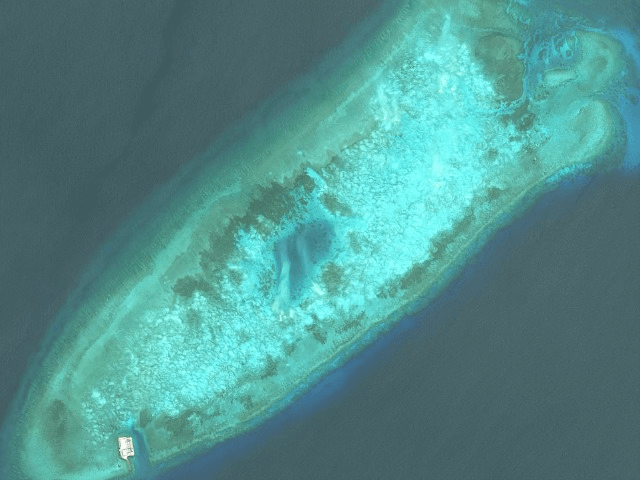A report updated this week suggests that China has continued to build advanced military facilities on illegally seized reefs and artificial islands in the South China Sea, as the anniversary of an international tribunal ruling against China on the matter nears.
The Asia Maritime Transparency Initiative at the Center for Strategic and International Studies (CSIS) published an update to its regular report on the Spratly Islands on Thursday, where China has constructed major surveillance facilities and placed military assets.
CSIS satellite images show new construction on three land formations: Fiery Cross, Mischief, and Subi Reefs. Mischief Reef boasts the beginnings of what appears to be “a very large antennae array … presumably boosting China’s ability to monitor activity around the feature.” Fiery Cross Reef features new “hardened shelters with retractable roofs,” which could serve to house missiles. Subi Reef appears equipped with new radar and surveillance equipment.
Any new surveillance equipment could pose a challenge to the Philippines and Vietnam, particularly oil exploration units or fishermen attempting to use the sovereign territory of either of these countries. In March, China banned Vietnam from fishing in its own territory in the Paracel Islands, a South China Sea archipelago, and has attacked and sunk Vietnamese fishing vessels on multiple occasions.
This month, Vietnam and China canceled a bilateral “Border Defense Friendly Exchange,” allegedly “due to Chinese displeasure at Vietnam’s resumption of oil exploration activities in the South China Sea,” according to the Diplomat. Following the break in that meeting, the Chinese state propaganda outlet Global Times quoted an “analyst” accusing Vietnam of “undermin[ing] the stability of the South China Sea, and violat[ing] China’s sovereignty and maritime rights.”
In addition to the new construction in the Spratly Islands, the CSIS notes that China appears to be constructing “very large underground structures” at a number of reefs in the area. The result of all the new construction, the experts conclude, is that “Beijing can now deploy military assets, including combat aircraft and mobile missile launchers, to the Spratly Islands at any time.”
The Spratly Islands are the sovereign territory of Vietnam and the Philippines. China claims almost the entire South China Sea, including land belonging to those two countries as well as Malaysia, Brunei, Taiwan, and the waters off of Natuna island, Indonesia.
In July 2016, the Permanent Court of Arbitration at the Hague ruled that China has no right to build military facilities in the Spratly or Paracel Islands, and that all its claims within the “nine-dash line” territory were invalid. China vowed to ignore the ruling, and no country in the region has challenged China’s presence there militarily.
The Chinese military has continued to expand its mobile maritime capabilities as well as the constructions on islands in the region. This week, China deployed some aircraft weaponry to Hainan island, near the “nine-dash line territories,” according to DefenseNews.
On Wednesday, the People’s Liberation Army also debuted a new warship “equipped with new air defence, anti-missile, anti-ship and anti-submarine weapons,” according to state-run news outlet Xinhua. Reuters describes the warship as a “new generation” destroyer, the first in what the Chinese government says will be a series of eighteen warships.
The United States has repeatedly condemned China’s growing illegal presence in the South China Sea. In early June, Secretary of Defense James Mattis demanded China cease “militarizing artificial islands and enforcing excessive maritime claims,” earning an outraged response from the Chinese Foreign Ministry.
“The Chinese side has noted their irresponsible remarks and hereby expresses strong dissatisfaction and firm opposition,” spokeswoman Hua Chunying responded. “It is totally within China’s sovereignty to deploy necessary defense facilities on its own territory.”

COMMENTS
Please let us know if you're having issues with commenting.